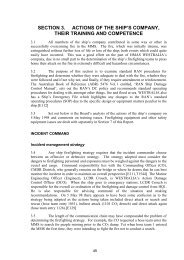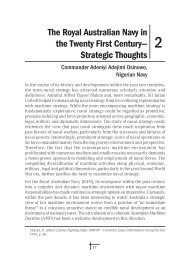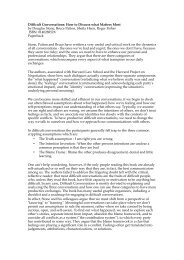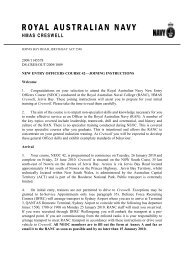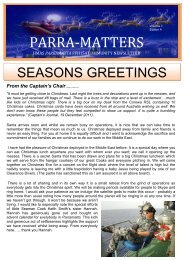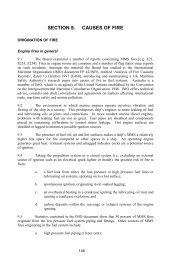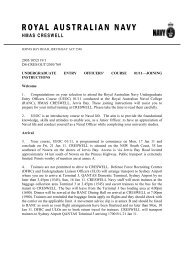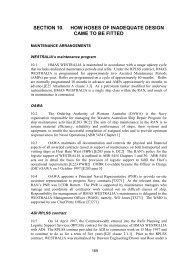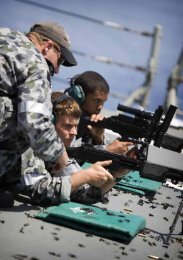30955 DEFENCE Mitchell Essay 02 - Royal Australian Navy
30955 DEFENCE Mitchell Essay 02 - Royal Australian Navy
30955 DEFENCE Mitchell Essay 02 - Royal Australian Navy
Create successful ePaper yourself
Turn your PDF publications into a flip-book with our unique Google optimized e-Paper software.
Manoeuvre Operations in the<br />
Littoral Environment<br />
2003 Winner Open Section<br />
Lieutenant Commander Robert Moyse,<br />
<strong>Royal</strong> <strong>Australian</strong> <strong>Navy</strong><br />
In any consideration of manoeuvrist theories it is necessary first to define what<br />
manoeuvre, in a military sense, is. Having done so it is then possible to judge<br />
its applicability, or otherwise, to Australia’s geostrategic and military strategic<br />
circumstances. It is fortuitous that history provides an excellent template against<br />
which many of these themes can be measured, in the form of operations in the<br />
South West Pacific from 1942 to 1945. This conflict was modern, in the sense<br />
that it took place in the air power era, but the lessons from it must be revisited<br />
in the light of subsequent and likely future developments. The practical<br />
application of any conclusions must be considered holistically, not in single-<br />
Service stovepipes, as modern warfare is intrinsically Joint.<br />
The concept of manoeuvre in warfare is, in its simplest form, to employ<br />
movement to apply one’s own strength against enemy weakness while avoiding<br />
the reverse. It is not a new concept. The great Chinese military philosopher,<br />
Sun Tzu, described the ‘indirect approach’. He saw the need for the ‘ordinary<br />
force’ to make a direct approach to pin the enemy, while the ‘extraordinary<br />
force’ took the indirect approach and struck his key vulnerabilities. Sun Tzu,<br />
like many subsequent military philosophers, considered manoeuvre in the<br />
context of the land environment. Operational Manoeuvre From The Sea (OMFTS)<br />
considers the problem from the joint perspective, using the sea as manoeuvre<br />
space to avoid the complications and obstructions which constrain manoeuvre<br />
on land. This idea is not a new one either. The Athenians, the Vikings and the<br />
British all practised it with varying degrees of success.<br />
Australia has an absolute dependence on free maritime passage and a deep<br />
level of integration with the regional economy. This dictates a maritime strategy<br />
including a need to be able to take action far from home and that is what<br />
Defence 2000 purports to be. Unfortunately it then goes on to describe a sea<br />
denial strategy which is a quite different thing. The missing ingredient is sea<br />
control, and this comprises sea assertion and power projection. 1<br />
1 Turner, S. (Admiral, United States <strong>Navy</strong>), Designing a Modern <strong>Navy</strong>.<br />
71<br />
7
72 PETER MITCHELL ESSAYS 2003<br />
Regional geostrategic and military factors make manoeuvrist concepts relevant<br />
to Australia. The <strong>Australian</strong> Regular Army is small, at just six readily available<br />
battalions. By comparison Malaysia claims 35 regular battalions and Indonesia 92.<br />
These crude figures do not allow for differences in readiness or quality, but<br />
the fact remains that neither the <strong>Australian</strong> Army nor the population base<br />
can support sustained land combat on the same scale as other regional powers.<br />
Australia must therefore employ manoeuvre to offset this.<br />
Australia’s environment is maritime and archipelagic. This is the only<br />
environment other than desert or Russian steppes in which the purest forms<br />
of manoeuvre theory can be applied. The practise of bypassing and isolating<br />
enemy strong points is much easier when one side can dominate the<br />
manoeuvre medium (ie. the sea) while denying it to an enemy. In this case a<br />
land-based enemy is pinned not by Sun Tzu’s ‘ordinary force’ but by water.<br />
Equally, striking key vulnerabilities from the sea is infinitely more practicable<br />
when nearly all the key military and economic infrastructure is within 20 miles<br />
of the coast. If any region of the world is ideal for OMFTS it is the South West<br />
Pacific. Self-evidently, this depends on sea control.<br />
The salient lesson of Second World War in the South West Pacific is that the<br />
advent of the ‘third dimension’, air power, fundamentally changed the nature<br />
of sea control. Engagements between opposing surface ships had far less impact<br />
in this theatre compared to those determined between aircraft and ships. At<br />
the Coral Sea, Midway and a string of other battles surface warships proved<br />
unable to defend themselves against air attack. They needed air power of their<br />
own. A nation that cannot project sustained air power into a non-permissive<br />
environment cannot lay claim to a maritime strategy, only a sea denial strategy.<br />
During the Second World War Nimitz and McArthur demonstrated a better<br />
understanding of the inter-relationship between sea, air and land power than<br />
the majority of modern strategists. McArthur did not expect to be able to rely<br />
on the <strong>Navy</strong>’s carriers, as their priority was in the Central Pacific, so he was<br />
reliant on land-based air power. He therefore determined that the airfields<br />
were the tactical centres of gravity and operational decisive points. He could<br />
control the sea only if he could control the airfields. He could control the<br />
airfields only if he could take and hold the land on which they stood. He could<br />
do this only if he could control the sea. This triangle was the key to the Allied<br />
campaign and to the Japanese blitzkreig that preceded it. They were on a<br />
much larger scale than could be expected today but the method is scalable<br />
and remains the key to control of the South West Pacific region in the 21 st<br />
Century. An example illustrates this point.
MANOEUVRE OPERATIONS IN THE LITTORAL ENVIRONMENT<br />
The strongest Japanese land force in the region, about 100,000 battle-hardened<br />
veterans was well dug in on Rabaul. The Allies defeated it without even landing<br />
there. The Japanese could not be strong everywhere and the Allies took a<br />
number of nearby areas from the sea, often against little or no opposition, and<br />
established air bases. The allied aircraft then mounted an intense offensive<br />
counter-air campaign to gain localised temporary air superiority, allowing<br />
further amphibious landings in the Admiralties, completely isolating Rabaul.<br />
After that the Rabaul-based Japanese quickly ran out of fuel and became as<br />
irrelevant as if they had been overrun, but at a fraction of the cost.<br />
Although manoeuvrist at the operational level, operations ashore were, of<br />
necessity, usually attritional and linear. The normal sequence was to establish<br />
a beachhead, build up combat power and then break out. This provides a degree<br />
of logistic insurance but slows tempo, sometimes negating the initial surprise<br />
of landing at an unexpected time and place, as occurred at Galipolli, Anzio<br />
and Salerno. The OMFTS solution is Ship to Objective Manoeuvre (STOM). By<br />
eliminating the operational pause at the beachhead it was hypothesised that<br />
sufficient tempo could be generated to capitalise on surprise and maintain<br />
the lead in the Observe-Orient-Decide-Act (OODA) loop. It is important to<br />
understand that STOM does not eliminate the problem of crossing beach; it<br />
only eliminates the pause to build up a reserve of combat supplies behind it.<br />
Remarkably, Australia has no joint concept for operations in an archipelagic<br />
region. In its absence Army took the lead in the late 1990s with Manoeuvre<br />
Operations in the Littoral Environment (MOLE), and its offshoot, Entry by Air<br />
and Sea (EAS). MOLE is a Whole-of Campaign concept, from initiation to the<br />
restoration of stability. The original intention of these two concepts was to<br />
provide a vehicle for Army experimentation to find how Army could best<br />
contribute to maritime strategy. The release of MOLE and EAS did more to<br />
promote progress in amphibious capability development in the <strong>Australian</strong><br />
Defence Force (ADF) than any other event, including real world operations.<br />
From a single-service point of view it is well argued, manoeuvrist and forward<br />
looking. Viewed from a joint maritime perspective, however, it has the flavour<br />
of an expeditionary continentalist strategy.<br />
MOLE starts with the problem of defeating the enemy ashore and works<br />
backward, paralleling the well-proven amphibious reverse-planning process.<br />
On this basis the HEADLINE Experiment found that Army required a Brigade<br />
of 3,000 to achieve EAS, although the amphibious element is less than one<br />
quarter of the total. Follow-on forces bring the total Army commitment to nearly<br />
9,000 personnel. This is highly ambitious2 and it could be argued that this is no<br />
longer a land contribution to a Joint Maritime Strategy, but vice versa.<br />
2 This is beyond the capability of any European nation except, arguably, the UK.<br />
73
74 PETER MITCHELL ESSAYS 2003<br />
Even if MOLE was affordable3 it is highly questionable if throwing the entire<br />
deployable strength of the Army into a single land operation is the best way<br />
to conduct archipelagic manoeuvre warfare. The Amphibious Manoeuvre<br />
Warfare paper4 approaches the issue from a maritime perspective and a broad<br />
estimate of affordability. Its underlying rationale is that Australia’s relative<br />
strength in technology and weakness in manpower militates against sustained<br />
warfighting embroilments ashore. It sees the projection of force ashore in the<br />
context of sea control rather than delivering forces for a sustained land<br />
campaign. It relies on isolation, bypassing by sea, striking key vulnerabilities<br />
ashore and re-embarking as soon as expedient.<br />
It acknowledges that Operations Other Than War (OOTW), such as Operation<br />
TANAGER (East Timor) may require larger land forces but these do not<br />
necessarily have to be delivered immediately and tactically. This is a maritime<br />
counterpart to the continentalist MOLE.<br />
The reverse planning process is a sound method of planning an amphibious<br />
operation using a given set of resources. It is not, however, a good way to<br />
develop a force structure. This sequential approach inevitably leads to trying<br />
to generate maximum combat weight ashore but this is seldom the most<br />
effective approach as it reduces cross-environment agility. The greatest<br />
advantage of an amphibious force is its ability to exploit information superiority<br />
then manoeuvre at sea to land where the enemy is weak. It achieves its mission<br />
by capitalising on surprise and keeping inside the enemy’s OODA loop. While<br />
it is at sea it is an operational level threat due to its mobility and<br />
unpredictability. Once ashore it is no more than a minor tactical force. The<br />
constraints of affordable amphibious shipping mean that it will rarely<br />
overmatch a shore-based opponent in a simple trial of strength.<br />
A balance is required between agility and combat weight and the mechanism<br />
for deriving such a force is joint iterative development. Clear higher-level<br />
direction on potential areas of operation and a free hand to develop innovative<br />
courses of action are essential. The development of a joint theatre-level concept<br />
of operations, tested by experimentation, is the most critical link in this<br />
process. Even at the tactical level the concept of operations must be derived<br />
Jointly before single-service experimentation can be meaningful. Such a<br />
process would almost certainly result in a very different set of Military<br />
Response Options to the current, somewhat linear, set.<br />
3 ‘The ability to conduct MOLE operations as presently conceived is likely to increase lift requirements<br />
dramatically, and require the acquisition costs to increase well beyond AUD 4-5 billion.’ Strategic<br />
Lift Study – Recommendations Page XVIII.<br />
4 Produced by AASG for DNSF in 20<strong>02</strong> as a contribution to FMOC 2<strong>02</strong>0.
MANOEUVRE OPERATIONS IN THE LITTORAL ENVIRONMENT<br />
If these manoeuvrist concepts are to be employed properly the consequences<br />
for Army and Air Force are every bit as revolutionary and unsettling as those<br />
for <strong>Navy</strong>. Sea assertion is impossible without guaranteed air power on demand. 5<br />
A few minutes with a calculator will show that, even with air-to-air refuelling<br />
and the relatively long-range Joint Strike Fighter, mainland-based fighter cover<br />
cannot be sustained at ranges relevant to a maritime strategy. Enabling air power<br />
over the battlespace would become the focus for joint maritime manoeuvre<br />
operations in much the same way as it was for Nimitz and MacArthur.<br />
This presents three big questions: Firstly, how is this force to be commanded;<br />
secondly, how can fighter support be provided; and thirdly, how does this<br />
change the role of the surface fleet?<br />
Australia in the 21st Century commands small combat forces yet maintains a<br />
command structure not dissimilar to that of major powers. There is<br />
considerable replication between the strategic, operational and tactical levels,<br />
and between environmental component headquarters. This is not compatible<br />
with the rapid, concurrent decision-making necessary to exploit modern<br />
knowledge-based, high-tempo manoeuvre operations. The separation<br />
frustrates close coordination and generates triplication (or worse) of effort.<br />
The profusion of headquarters soaks up huge resources yet, paradoxically,<br />
leads to each being inadequately staffed. A rationalisation of Australia’s<br />
strategic and operational command structure would be necessary to prevent<br />
high-level decision-drag from defeating the potential tempo gains of<br />
manoeuvre warfare. It would also release resources.<br />
At the sharp end the Joint Force Commander must be in-theatre, and therefore<br />
capable of operating from afloat. The friction caused during the Falklands<br />
War by geographic separation has been well documented. Modern networked<br />
communications can overcome many of the technical problems of 21 years<br />
ago but the human factor has not changed.<br />
Existing tactical Command and Control (C2) doctrine is well proven and the<br />
case to change it is unproven. In particular, fiddling with the Commander<br />
Amphibious Task Force (CATF)/Commander Landing Force (CLF) relationship<br />
has a bad track record and should not be attempted. Furthermore, the Joint<br />
Force Commander (JFC) and the CATF each require comprehensive facilities<br />
and freedom from interference. The JFC should not, therefore, be located in<br />
the amphibious command ship under any circumstances. This implies a need<br />
for JFC facilities elsewhere in the fleet.<br />
5 Turner, S., Designing a Modern <strong>Navy</strong>.<br />
75
76 PETER MITCHELL ESSAYS 2003<br />
The self-evident answer to the fighter support question is the aircraft carrier.<br />
The argument that the ADF could not afford to procure, crew and maintain a<br />
carrier is fallacious; it is a question of priorities. If expeditionary operations<br />
are the Government’s priority the real question is ‘what do we give up to pay<br />
for it?’ to which the answer has to be ‘whatever we must’. There are significant<br />
elements of the existing ADF structure of little or no relevance to a maritime<br />
strategy. Capabilities must be aligned to strategically relevant joint operational<br />
concepts, not ingrained habits.<br />
Spain, on a defence budget one-third smaller than Australia6 operates a modern<br />
carrier. Italy will operate two from 2007. Neither of these countries is an island<br />
nor located in a region as intrinsically maritime as South East Asia.<br />
If a carrier is deemed politically unacceptable then the only alternative is<br />
expeditionary land-based air power. In any event it is a desirable complement<br />
to carrier power. The only way to secure, defend and improve the minor<br />
airfields on the myriad islands in the region is by amphibious power projection<br />
and the only way to provide the huge quantities of fuel required to support<br />
sustained air operations is by sea. In this case the RAN must be able to conduct<br />
effective, high-tempo amphibious operations and medium-scale logistic<br />
support from the sea in order to have the air cover it needs to gain sea control.<br />
This would see <strong>Navy</strong> structured to generate three task forces: a Carrier Group,<br />
an Expeditionary Strike Group (ESG) and an Expeditionary Support Group. It<br />
is worth considering each in turn.<br />
<strong>Navy</strong> has lost the corporate expertise to conduct fixed-wing air operations<br />
and the pragmatic answer to creating a carrier aviation capability is a joint<br />
approach with Air Force doing the flying. Creation of a single point of authority<br />
for this would be wise if we wish to avoid replicating the inefficiencies that<br />
have plagued ADF amphibious development, which will be discussed below.<br />
6 Spain’s budget for 20<strong>02</strong> was US$8.6B according to the CIA Source Book 2003. Australia’s<br />
was US$11.39B.
MANOEUVRE OPERATIONS IN THE LITTORAL ENVIRONMENT<br />
Amphibious operations are widely recognised as the most challenging of all<br />
types of military operation. Non-specialised amphibious forces have a<br />
surprising record of success in amphibious warfare7 but only after painful,<br />
often disastrous introductions and subsequent near-vertical learning curves.<br />
This is an old, oft-repeated lesson. A force the size of the ADF cannot afford a<br />
Dieppe. 8 It must get its amphibious operations right first time, every time.<br />
This demands an integrated, high readiness, purpose-designed Joint<br />
Amphibious Force. Nothing less is adequate for the high-tempo, STOM-based<br />
operations necessary to avoid bogging down into an attritional slogging match.<br />
An Expeditionary Strike Group (ESG) is a self-contained littoral manoeuvre<br />
force. It comprises an Amphibious Ready Group (ARG), 9 advance forces for<br />
shaping, including rapid environmental/threat assessment, and surface<br />
combatants. The inclusion of the surface combatants provides not only<br />
protection but also long-range precision land attack and close support to<br />
forces ashore.<br />
At the tactical level, amphibious doctrine demands compliance with the first<br />
principle of Command and Control – Unity of Command. At the capability<br />
management level there is no parallel. The stove-piped nature of single-Service<br />
driven capability development has hamstrung ADF amphibious progress for<br />
7 th<br />
According to Gatchel (1996), of nearly one hundred significant landings conducted in the 20<br />
century, only four were ever repulsed – the initial Japanese assault on Wake Island, Pandan in<br />
the Philippines, Milne Bay, and the British landing at Dakar. Gatchel, T.L., At the Water’s Edge –<br />
Defending Against Amphibious Assault, Naval Institute Press, 1996. Two of these are<br />
questionable. The initial landing of a small part of the Japanese force at Pandan was successful,<br />
although reinforcements were delayed for a day by weather and American air attacks. The<br />
landing at Dakar was called off at the last minute when intelligence showed the enemy strength<br />
was too great. The initial Japanese assault on Wake Island on 11 December 1941 was repulsed,<br />
but the second attempt on 23 December was successful. The Japanese landed at Milne Bay on<br />
26 August 1942 and established a beachhead, but they were unable to break out. The surviving<br />
troops were withdrawn on 4-5 September 1942 and no further landing was attempted.<br />
8 An amphibious raid was conducted on the French port of Dieppe on 19 August 1942, with a<br />
force of just over 6000, primarily consisting of troops from the 2nd Canadian Infantry Division.<br />
The raid failed, with many troops pinned down on the beaches and subsequently killed or<br />
forced to surrender. The British lost 106 aircraft, a destroyer, 33 landing craft, and 29 tanks,<br />
and suffered 1380 dead, 1600 wounded and over 2000 captured. The Germans lost 48 aircraft<br />
and one shore battery, and suffered 345 dead and 268 wounded.<br />
9 In an <strong>Australian</strong> sense this would be a more modest version of its US equivalent, which<br />
comprises a ground combat element of a Battalion Landing Team, an air combat element of<br />
attack and support helicopters, a combat support force all mounted in three ships. These<br />
comprise one multipurpose Amphibious Assault Ship with well deck (LHA) or multipurpose<br />
Amphibious Assault Ship with helicopter capability (LHD), one Amphibious Transport Dock<br />
with helicopter deck (LPD) and one Dock Landing Ship (LSD). See USN web site for details.<br />
77
78 PETER MITCHELL ESSAYS 2003<br />
decades. Despite a superficially impressive order of battle (ORBAT), the ADF<br />
amphibious capability remains considerably less than the sum of its parts, as<br />
it has never exercised in its entirety, seems unlikely to in the foreseeable<br />
future, and shows little prospect of improving.<br />
Almost every defence force with any serious amphibious aspirations<br />
designates clear responsibility for the net capability. In the United Kingdom<br />
(UK) one of the 2-Star operational afloat commanders is designated<br />
Commander UK Amphibious Force (COMUKAMPHIBFOR). He is also the<br />
effective ‘owner’ of amphibious capability – ships, helicopters and landing force.<br />
The Americans, Dutch and Spanish have different but no less effective<br />
arrangements. The similarity is that in all these countries amphibious<br />
capability has unambiguous ownership and permanent complemented staffs.<br />
In an <strong>Australian</strong> context a one-star appointment, rotating between Army and<br />
<strong>Navy</strong>, supported by a fairly small staff would be appropriate.<br />
The purpose of the third element, the Expeditionary Support Group, is to provide<br />
logistic support to land and air forces operating ashore and should not be<br />
confused with naval replenishment, which must be integral to the Carrier Group<br />
and the ESG. The conceptual development of this force has not even begun.<br />
No consideration of a naval structure to support maritime strategy can ignore<br />
submarines. The United States <strong>Navy</strong> (USN) is driving towards integration of<br />
submarines with surface forces and there is no doubt that this would bring<br />
great advantage if underwater network centric warfare is ever realised. There<br />
is, however, a fundamental difference between nuclear submarines with<br />
unlimited high-speed endurance and non-nuclear submarines. Full integration<br />
may play to the diesel submarine’s weaknesses rather than its strengths. A<br />
balance between independent and non-independent operations would need<br />
to be derived, as sea denial remains indispensable to maritime strategy.<br />
There are many obstacles to reorientation of <strong>Australian</strong> defence to a<br />
manoeuvrist stance. Many, such as funding and inter-service rivalry, are<br />
obvious but at the root of all these lies culture and that is the most difficult to<br />
change. Defence as a whole is wedded to the romanticism of the past – Gallipoli,<br />
Tobruk and the Citizen Army. World dynamics and <strong>Australian</strong> society have<br />
changed, almost beyond recognition and long lead-time, empire-oriented<br />
structures that served then are utterly inappropriate for the ‘just enough, just<br />
in time’ 21st Century.<br />
Each single-Service culture is of inestimable value, but each also contains<br />
elements of environmental-myopia that obstruct the development of net<br />
defence capability. Each Service can see the faults of its partners but it behoves<br />
us to examine our own first.
MANOEUVRE OPERATIONS IN THE LITTORAL ENVIRONMENT<br />
Within the <strong>Royal</strong> <strong>Australian</strong> <strong>Navy</strong> (RAN) traditional surface warfare still holds<br />
a pre-eminent cultural position, much as battleship engagements did in the<br />
<strong>Royal</strong> <strong>Navy</strong> (RN) prior to the Second World War. Fleet-versus-fleet surface<br />
warfare has become the least likely form of combat. 10 Enemy surface ships<br />
are low on the list of threats facing Australia and our own surface ships are a<br />
comparatively inefficient way of countering them compared to aircraft and<br />
submarines. Similarly, emphasising air defence using the ship’s organic systems<br />
is asymmetric warfare reversed. If properly employed as part of a joint maritime<br />
manoeuvre force they should never find themselves in such a situation. A<br />
refocusing on sea assertion and power projection would see surface combatants<br />
revert to the escort role. This exploits their strengths11 rather than exposing<br />
their vulnerabilities12 by viewing them as stand-alone capital units.<br />
In summary, the present generation of manoeuvrist theories contains little<br />
that is fundamentally new. What they do offer is a rejuvenated emphasis on<br />
manoeuvre in a holistic sense rather than a land-centric sense and when<br />
applied to Australia’s geostrategic circumstances they lead logically to a joint<br />
maritime manoeuvre strategy. This is at odds with present Defence Policy,<br />
which proposes force projection without relating it to sea control. This is<br />
intellectually bankrupt. Similarly, MOLE and EAS in their present forms are<br />
not elements of a maritime strategy; they are expeditionary versions of a<br />
continental strategy. A joint concept for maritime archipelagic warfare is<br />
essential. It must address the contentious issue of the tactical command<br />
structure and this must be directed by a more logical and responsive higher<br />
headquarters structure.<br />
Tribal culture is the greatest single-Service strength but, collectively, the<br />
greatest obstacle to a holistic approach to matching defence policy to national<br />
strategic needs. Shifting to a maritime strategy does not imply a navalist<br />
strategy. Comprehensive sea control is a joint task and new capabilities would<br />
be required by all three Services. Some of the most sacred of the sacred cows<br />
would have to be sacrificed to pay for them. A significant portion of the Defence<br />
budget is spent on barely deployable capabilities of little or no relevance to<br />
archipelagic manoeuvre operations.<br />
10 Friedman, N., O’Brasky, J.S. & Tangredi, S.J., Globalization and Surface Warfare.<br />
11 See <strong>Australian</strong> Maritime Doctrine, pp. 48-51.<br />
12 See <strong>Australian</strong> Maritime Doctrine, pp. 51-54.<br />
79
80 PETER MITCHELL ESSAYS 2003<br />
Within the RAN the requirement to develop carrier air power, conduct hightempo<br />
amphibious manoeuvre and support land-based expeditionary air power<br />
would require fundamental change. The capital ships of joint maritime<br />
manoeuvre are the carrier and the assault ship. Surface combatants remain<br />
key enablers, as escorts, but no longer as the raison d’être of the <strong>Navy</strong>.<br />
Whether RAN culture could absorb this remains the great unanswered<br />
question. If it cannot there is little point expecting the RAAF to convert to a<br />
genuinely expeditionary mindset or asking the Army to generate a US Marine<br />
Corps-style maritime manoeuvre focus. If, on the other hand, each of the three<br />
Services makes the cultural shift Defence as a whole will follow, to the<br />
immeasurable benefit of the <strong>Australian</strong> Government and our national security.<br />
Bibliography<br />
Friedman, N., O’Brasky, J.S. & Tangredi, S. J., ‘Globalization and Surface Warfare’,<br />
in Globalization and Maritime Power, Tangredi, S.J. (editor), Institute for National<br />
Strategic Studies, National Defense University Press, Washington, 20<strong>02</strong>.<br />
Gatchel, T.L., At the Water’s Edge – Defending Against Amphibious Assault, Naval<br />
Institute Press, Annapolis, Maryland, 1996.<br />
<strong>Royal</strong> <strong>Australian</strong> <strong>Navy</strong>, <strong>Australian</strong> Maritime Doctrine, Defence Publishing<br />
Service, Canberra, 2000.<br />
Strategic Lift Study – Recommendations.<br />
Turner, S., Designing a Modern <strong>Navy</strong>.



